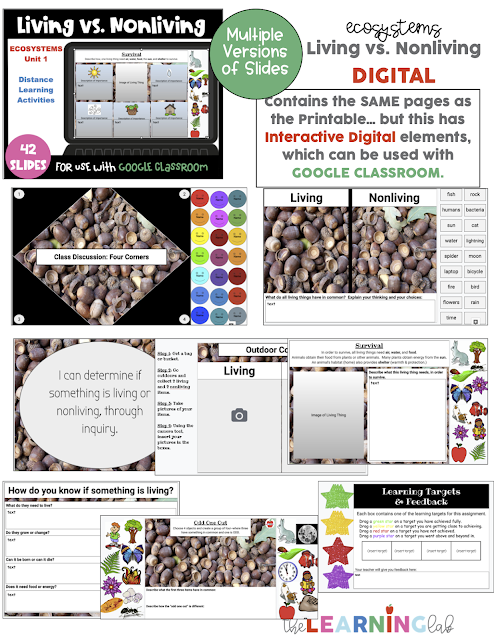This HUGE Ecosystem bundle is both DIGITAL and PRINTABLE, with over 190 printable pages and over 190 slides. The digital version is compatible with Google Classroom and perfect for Distance Learning.
There are three units in this bundle, which include: living vs. nonliving, food chains and food webs, and producers, consumers, and decomposers.
DIGITAL VERSION (combined 194 slides):
- Learning Target Slides (editable & fixed)
- Informational Slides
- Visual Supports
- Interactive Activities or Investigations (Decomposition Column, Observations, Whole-Group Formative Assessment, etc.)
- Interactive tasks and worksheets (many are editable)
- Vocabulary
- Assessments
- Student Learning Targets & Feedback Rubric through Self-Scoring (editable)
PRINTABLE VERSION (combined 195 pages):
Lesson plan ideas/activities, following inquiry and the 5Es
Learning Targets to post in the room
Picture Sorts
Science Worksheets
Graphic Organizers
Posters and Visuals to post in the classroom
Journal writing prompts
Journal investigation prompts
Vocabulary definitions, worksheets, and answer key
Sorting Cards/Concept Cards
Examples of student work
Directions on How to Make a Decomposition Column
Article “What is All That Rot?”
Clip Art Images
Various Assessments (pre and post) and Assessment ideas
Modification and Extension ideas
Extra Copies--with or without frames
Technology Skills:
* Camera Tool to insert image
* Selecting
* Dragging elements
* Resizing image
* Text boxes
* Shapes tool
Self-Assessment & Feedback
Each digital unit comes with an editable rubric.
Unit 1: Living versus Nonliving
This is a collection of lessons and activities following the 5Es of science. Students will decide if something is living or nonliving through inquiry-based and STEM or STEAM activities. See more images here.
Students will meet in Scientists Meetings to develop criteria for all living things. They will be asked to do independent journal writing, whole-class brainstorming, as well as Think*Pair*Share work. Once students have come up with “What all Living Things Need”, they will classify things as living and nonliving, based on their criteria. Finally, students will demonstrate their understanding of this criteria that living things grow, reproduce, need water, need air, and need energy.
This unit includes formative assessment activities and an assessment probe (which can be used as a pre-assessment then again as a post-assessment). There are several graphic organizers included. Includes assessment ideas, modification possibilities, and follow up strategies.
This single unit can be purchased here, apart from the bundle.
The entire Ecosystem Bundle can be purchased here in my TPT Store!
Samples of Printable Version:
Samples of Digital Version:
Unit 2: Food Chains and Food Webs
Samples of Printable Version:
Samples of Digital Version:
Unit 3: Producers, Consumers, and Decomposers
Samples of Printable Version:
Samples of Digital Version:




















.png)
.png)








No comments